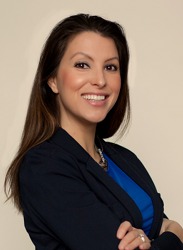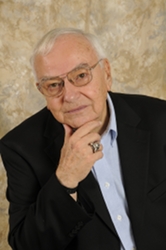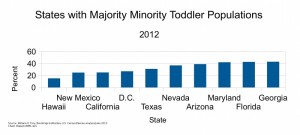Posted by Elena del Valle on July 22, 2013

JJ DiGeronimo, CEO, Purposeful Woman
Photo: Purposeful Woman
A podcast interview with JJ DiGeronimo, CEO, Purposeful Woman, is available in the Podcast Section of Hispanic Marketing & Public Relations, HispanicMPR.com. During the podcast, she discusses using social media to build business with Elena del Valle, host of the HispanicMPR.com podcast.
JJ is a businesswoman who loves her work and her family. She has developed leadership strategies designed to increase the influence and impact of working women. In her books, her blogs and her presentations, she strives to help high impact women prioritize, align and achieve their individual goals.
She is the founder of Purposeful Woman, Tech Savvy Women, and Journey Charms. She is the author of The Working Woman’s GPS. She’s a spokesperson for Science Technology Engineering and Math (S.T.E.M.).
To listen to the interview, scroll down until you see “Podcast” on the right hand side, then select “HMPR JJ DiGeronimo” click on the play button below. You may download the MP3 file to your iPod or MP3 player to listen on the go, in your car or at home by clicking on “Get HMPR Podcast” above the podcast player. The podcast will remain listed in the July 2013 section of the podcast archive.
Posted by Elena del Valle on July 15, 2013

Aaron Young, CEO, Laughlin Associates
Photo: Laughlin Associates
A podcast interview with Aaron Young, CEO, Laughlin Associates, is available in the Podcast Section of Hispanic Marketing & Public Relations, HispanicMPR.com. During the podcast, he discusses corporations versus LLCs with Elena del Valle, host of the HispanicMPR.com podcast.
For 20 years Aaron has been advising companies on which type of business form is right for them. His company, Laughlin Associates, is located in Reno, Nevada. At age 18, he formed a recycling company in Portland, Oregon, before recycling was popular. He grew that business to 5,000 customers before selling it and using the money to become one of the first cellular phone dealers in Portland. He built that business to include three stores and a large service center, still in operation today.
He sold the company and became vice president of sales for ITEX, a publicly-traded NASDAQ company with 350 offices around the world. After three years, he left the company and formed several small corporate-services businesses before buying Laughlin Associates. He writes a monthly column in Small Business Today and blogs for Small Business 411.
To listen to the interview, scroll down until you see “Podcast” on the right hand side, then select “HMPR Aaron Young” click on the play button below. You may download the MP3 file to your iPod or MP3 player to listen on the go, in your car or at home by clicking on “Get HMPR Podcast” above the podcast player. The podcast will remain listed in the July 2013 section of the podcast archive.
Posted by Elena del Valle on July 12, 2013

In Living Color
Nina Jablonski, professor, Anthropology at Pennsylvania State University believes there is no such thing as a pure race. Her research indicates skin color developed as a way for humans to adapt to their surroundings and over time became a means, with little relationship to reality, to label someone’s social worth. In Living Color: The Biological and Social Meaning of Skin Color (California University Press, $29.95) she explores these concepts.
The 260-page hardcover book published in 2012 is divided into two main sections. In the first half of the book, she examines the biology of skin tone and how over the centuries skin pigmentation allowed people to adjust to their environment. Skin color in pale people comes from blood and the skins own connective tissues. Eumelanin is the dominant source of skin color in general. Light skin was necessary for populations living in regions with little sunlight while dark skins shades were useful in places with an abundance of sunlight. She addresses the challenges brought about when migration, travel and modern life cause people to live away from their ancestral home, citing vitamin D deficiency as one of the dangers.
In the second half of the book, she delves into the origin of the concept of race saying there is no such thing as pure human populations or races. Over history, she says, people mixed with other people around the globe resulting in mongrel groupings with only minor variances. In time, European elites contributed to the idea of races categorized by skin color, social worth and cultural capability. Because of its association with positive aspects and high standing a preference for light skin arose independently in different countries, according to the professor.
This in turn led to the social stratification, discrimination and racism that endure today. She goes on to say in the closing chapter that in the United States and many developed countries people with the darkest skin color remain in the “periphery of society” and are physically marginalized suffering from restricted access to high quality education, food, and health care.
Jablonski, recipient of the 2012 Guggenheim Fellowship, is also author of Skin: A Natural History.
Comments:
Filed Under: Books
Posted by Elena del Valle on July 8, 2013

Stephanie DaCosta, media director, Wing
Photo: Wing
A podcast interview with Stephanie DaCosta, media director, Wing, is available in the Podcast Section of Hispanic Marketing & Public Relations, HispanicMPR.com. During the podcast, she discusses how Univision beat a major network in ratings with Elena del Valle, host of the HispanicMPR.com podcast.
Born to Cuban parents and raised in Miami, Stephanie was at Crispin Porter and Bogusky prior to joining Wing. While there, she worked on the Burger King, Domino’s Pizza, Ask.com and Sprite accounts. She also spent some time in New York City working at Universal McCann and Carat on DTC and OTC brands within Pfizer and Johnson & Johnson, as well as Pernod Ricard.
Her 10 year career includes experience in buying and planning across various media nationally and locally. Her love of exploring different cultures recently inspired her to pursue her Master’s in Sociology and Anthropology.
To listen to the interview, scroll down until you see “Podcast” on the right hand side, then select “HMPR Stephanie DaCosta” click on the play button below. You may download the MP3 file to your iPod or MP3 player to listen on the go, in your car or at home by clicking on “Get HMPR Podcast” above the podcast player. The podcast will remain listed in the July 2013 section of the podcast archive.
Posted by Elena del Valle on June 28, 2013

You Can Beat Lung Cancer
Photos: Carl Helvie, Francisco Contreras, Tanya Harter Pierce, Bernie Siegel
Carl Helvie, RN, DrPH, now 81 years old, was told 38 years ago that he had lung cancer and only six months left to live. He recovered with alternative healing methods in lieu of traditional cancer medical treatments such as surgery and chemotherapy. Today, he’s healthy, takes no prescription medications and is one of the longest living cancer survivors, according to You Can Beat Lung Cancer: Using Alternative/Integrative Interventions (Ayni Books, $26.95). The 312-page softcover book published this year is divided into four main sections: an overview of lung cancer, the author’s own experience, medical issues, and holistic treatment options.
“Harsh chemicals, devastating surgeries and painful procedures for conventional cancer treatment are not your only option,” said Helvie in a press release. “I saw that lung cancer survival rates had not changed over time and wanted people to know there are other non-toxic, non-invasive treatment options that are successful and I could speak as both a profession health care provider and educator and also as a long term survivor who use non-toxic interventions,” he said by email when asked why the wrote the book now.
Helvie relied on holistic natural methods to treat his condition: supplements, herbs, enzymes, diet, prayer and meditation. His quality of life since the diagnosis of lung cancer has been superior than people often expect at his age. He points out that many older Americans have some form of chronic illness and by age 75 may be taking five prescribed medications daily.
Helvie is not surprised by the recent findings of a team of researchers in Washington State who discovered that chemotherapy fuels the growth of cancer cells, making it more difficult to destroy them in subsequent sessions.

Carl Helvie, RN, author, You Can Beat Lung Cancer
“No I do not receive money for services or products. As a cancer survivor and registered nurse I believe in helping others and the help I can provide should be offered for free,” said the author by email in response to a question about whether he sells products or services to treat lung cancer. “I communicate with around 60 cancer patients monthly and provide encouragement, support, and resources as best meets their needs. God saved my life when I had cancer and I believe in offering whatever I can as futher evidence that God is in all of our lives.”

Francisco Contreras, M.D.

Tanya Harter Pierce, MA, MFCC
A registered nurse with two masters and a doctorate in public health and wellness, Dr. Helvie has decades of experience as a nurse practitioner, educator, author and researcher. According to promotional materials, he has published eight books and was a contributor to others, and has published or presented 100 papers and articles in the United States and abroad. Also, he developed and published a nursing theory used worldwide, and established a nursing center to provide primary care for homeless and low-income individuals and families. He hosts the Holistic Health Show on BBS Radio, counsels cancer patients, markets his books and is in the process of establishing a holistic cancer foundation.

Bernie Siegel, M.D.
Francisco Contreras, M.D., president and chairman, Oasis of Hope Hospital; Kim Dalzell, Ph.D., RD, LD, who has helped people with nutrition and cancer; James Forsythe, M.D., HDM, who practices integrative medical oncology and anti-aging medicine; Tanya Harter Pierce, MA, MFCC, author, Outsmart Your Cancer; and Bernie Siegel, M.D., a physician and author, also contributed to the book.

Click to buy You Can Beat Lung Cancer
Comments:
Filed Under: Books
Posted by Elena del Valle on June 24, 2013

States with Majority Minority Toddler Populations 2012 – click to enlarge
For years there has been debate about the demographic face of America. Experts have estimated growth, births, deaths and juggled data to predict what our country will look like in coming decades. Newly analyzed Census 2010 information points to an unprecedented change in our nation’s racial and ethnic profile in 14 states. Data on ten of the states is represented in the graphic in this article. Four additional states were excluded to keep the graphic size manageable: New Jersey, New York, Mississippi and Delaware.
Non Hispanic whites are dying at a faster rate than they are born. This was anticipated. The speed at which it is happening is what is unexpected. Three states, Texas, New Mexico and California, have already reached majority-minority status, according to The Brookings Institution, a nonprofit public policy organization.
William Frey, senior fellow there, indicated in a recent article (Shift to a Majority-Minority Population in the U.S. Happening Faster than Expected) that the country is at the beginning of “an inevitable transition that affords us new opportunities.” Booming minority births, fewer births and more deaths among whites, and immigration are driving these changes, according to his article.
Posted by Elena del Valle on June 19, 2013
By Edward M. Bury, APR

Edward M. Bury, APR
Photo: Edward M. Bury
The numbers are astounding. And, as you read this, they continue to grow. And grow.
The subject in question is the online communications medium once known as a “weblog,” but much better known today as a blog.
Want some statistics? A site called Worldomenters.info reports that more than 3 million new blog posts are published daily. WordPress, a very popular open source platform content management system reported that it registers around 100,000 new bloggers each day.
Read the entire Four Tasks to Take On Before Launching a Business Blog
Posted by Elena del Valle on June 17, 2013

Homemade hummus, a spread made with mashed chickpeas, oil, garlic, and lemon juice
Photo: HispanicMPR
Americans like ethnic foods. That market segment is estimated at $8.7 billion for last year. Young adults and families with children like to prepare ethnic foods at home. Nine of ten adults 25 to 34 years of age in the United States who took a Mintel survey said they prepared ethnic food at home the previous month.
Among older adults 65 and older who took the survey 68 percent responded positively to the same question. Most people with children at home, 91 percent, said yes to the question compared to 78 percent among people with no children.
Mintel analysis in Ethnic Foods US January 2013 indicates the 12 percent growth in ethnic food sales between 2007 and 2009 was due to people eating in restaurants less often and dining at home more often to save money. While growth of ethnic food slowed to 4.5 percent from 2010 to 2012, according to Mintel that market segment is forecast to grow 20 percent between 2012 and 2017.
Hispanic food among survey takers was the most popular. More than half, 58 percent, said they prepared Hispanic food within the last month versus 55 percent who indicated they made Italian dishes and 44 percent who chose Asian food.
“The popularity of Hispanic food is likely due to how mainstream it has become in the US and the ease and convenience of preparing it,” said John N. Frank, category manager, CPG food and drink, Mintel, in a press release. “The endless supply of Mexican, Cuban and other Hispanic-based restaurants have given home cooks infinite possibilities for re-creating these restaurant-style meals at home.”
The largest (in terms of sales) of the ethnic food market’s five segments, per Mintel data, is Mexican/Hispanic although the growth for that type of food was negligible from 2010 to 2012. The next segment, while much smaller, corresponds to Asian food which had a 10.2 percent dollar sales increase and a 1 percentage point market share growth in the same time period.
Mediterranean/Middle Eastern foods, the third largest segment while much smaller than the other two, grew the most in those two years and is forecast to grow the most in dollar sales between 2012 and 2017. The ethnic food category, Mintel research indicates, responds to price and deals. Survey respondents exhibited low brand loyalty.
Authenticity is the top ethnic food characteristic, according to a July 2012 article (Research Spotlight: Ethnic Foods: Flying High) in SpecialtyFood.com. The article suggests that food manufacturers and marketers would increase consumer interest in their products, women and seniors in particular, by providing and promoting products with health benefits which interest both segments.






















